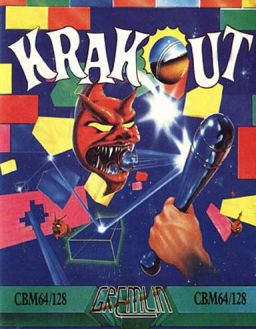
Krakout is a Breakout clone that was released for the ZX Spectrum, Amstrad CPC, BBC Micro, Commodore 64, Thomson computers and MSX platforms in 1987. One of the wave of enhanced Breakout variants to emerge in the wake of Arkanoid, its key distinctions are that gameplay is horizontal in layout, and that it allows the player to select the acceleration characteristics of the bat before playing. It was written by Andy Green and Rob Toone and published by Gremlin Graphics. The music was composed by Ben Daglish.

Laser Squad is a turn-based tactics video game, originally released for the ZX Spectrum and later for the Commodore 64, Amstrad CPC, MSX, Amiga, Sharp MZ-800 and Atari ST and PC computers between 1988 and 1992. It was designed by Julian Gollop and his team at Target Games and published by Blade Software, expanding on the ideas applied in their earlier Rebelstar series. Laser Squad originally came with five mission scenarios, with an expansion pack released for the 8-bit versions, containing a further two scenarios.

Army Moves is a scrolling shooter game developed by Dinamic Software for the Amiga, Amstrad CPC, Atari ST, Commodore 64, MSX and ZX Spectrum. It is the first chapter of the Moves Trilogy and was followed by Navy Moves in 1987 and Arctic Moves in 1995. It was first released in 1986 and published by Dinamic in Spain and by Imagine Software. Dinamic Software also developed a MS-DOS version of the game, published in 1989 in Spain.
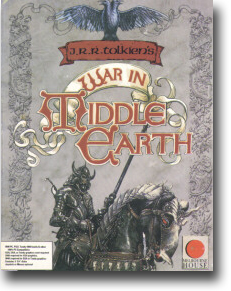
War in Middle Earth is a real-time strategy game released for the ZX Spectrum, MSX, Commodore 64, Amstrad CPC, MS-DOS, Amiga, Apple IIGS, and Atari ST in 1988 by Virgin Mastertronic on the Melbourne House label.

The Untouchables is a video game released by Ocean Software in 1989 on ZX Spectrum, Amstrad CPC, Commodore 64, MSX, Atari ST, Amiga, DOS, NES, and SNES. It is based on the film The Untouchables.
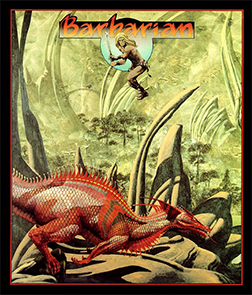
Barbarian is a 1987 platform game by Psygnosis. It was first developed for the Atari ST, and was ported to the Amiga, Commodore 64, MS-DOS, MSX, Amstrad CPC, and ZX Spectrum. The Amiga port was released in 1987; the others were released in 1988. The cover artwork is by fantasy artist Roger Dean.

Aliens: The Computer Game is a 1986 video game developed by Software Studios and published by Electric Dreams Software initially for Amstrad CPC, Commodore 64 and ZX Spectrum. It is based on the film of the same title. Ports for the Commodore 16 and MSX were developed by Mr. Micro and published in 1987.
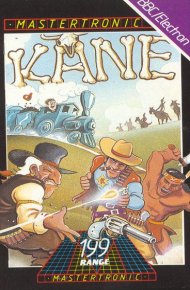
Kane is a multi-section action game published by Mastertronic for the Commodore 64 in 1986. It was ported to the Acorn Electron, Amstrad CPC, BBC Micro, ZX Spectrum, and the Commodore 16 and Plus/4. The game is set in the Wild West, and its name is a reference to the main character of the film High Noon. It consists of four distinct scenes, although some versions only contain two. A sequel was released in 1988.

Graphic Adventure Creator is a game creation system/programming language for adventure games published by Incentive Software, originally written on the Amstrad CPC by Sean Ellis, and then ported to other platforms by, amongst others, Brendan Kelly (Spectrum), Dave Kirby and "The Kid" (C64). The pictures in the demo adventure, Ransom, were made by Pete James and the box cover art by Pete Carter.

10th Frame is a ten-pin bowling simulation game published by Access Software in 1986. Up to eight players can take part in open bowling or a tournament. It was released for the Amstrad CPC, Atari ST, Commodore 64, IBM PC compatibles, MSX, and ZX Spectrum.
Alligata Software Ltd. was a computer games developer and publisher based in Sheffield in the UK in the 1980s.

180 is a darts video game released for the ZX Spectrum, Commodore 64, Amstrad CPC, and Atari 8-bit computers in 1986 and MSX in 1987.
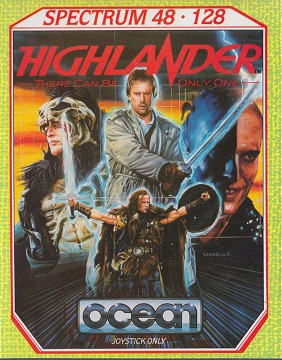
Highlander is a 1986 fighting game developed by Canvas and published by Ocean Software for the ZX Spectrum, Commodore 64, and Amstrad CPC home computers. It is based on the 1986 film of the same name. Highlander was panned by reviewers.

Saboteur II: Avenging Angel, also known as Saboteur 2, is an action-adventure game created by Clive Townsend and released by Durell Software in 1987 for the ZX Spectrum, Amstrad CPC, Commodore 64, and MS-DOS compatible operating systems. A sequel to 1985's Saboteur, the player controls a sister of Ninja from the first game on a mission to avenge his death. Saboteur II was one of the first action-adventure games with a female protagonist and was well received by critics.

Zoids: The Battle Begins is a 1986 video game designed by Chris Fayers, developed by the Electric Pencil Company, and published by Martech. and released in Europe for the ZX Spectrum, Amstrad CPC, MSX and Commodore 64 computers. Based on the Zoids toy series, the player controls a human who was fused with one of the robots and has to reclaim parts of a larger mech.

Game Over II is a combination scrolling shooter and platform game developed and published by Dinamic Software in 1987 for the ZX Spectrum, MSX, MS-DOS, Amstrad CPC, Commodore 64, and Atari ST.

Survivors is a puzzle video game published by Atlantis Software in 1986 for the ZX Spectrum. It was ported to the MSX, Atari 8-bit computers, Commodore 64, Commodore 16, Acorn Electron, and BBC Micro and the Amstrad CPC (1988). It is based on the "rocks and diamonds" mechanics of Boulder Dash.
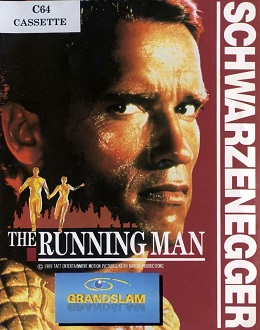
The Running Man is a 1989 beat 'em up video game based on the 1987 film of the same name. It was developed by Emerald Software and published by Grandslam Entertainments for Amiga, Amstrad CPC, Atari ST, Commodore 64, and ZX Spectrum.

Joe Blade is a video game published by Interceptor Micros on their Players budget label for the ZX Spectrum, Commodore 64 and Amstrad CPC in 1987. It reached the top of the UK game charts, replacing Renegade. In Germany, the game peaked at number 7. It was ported to the Acorn Electron, BBC Micro, Atari 8-bit computers, MSX, Amiga, and Atari ST. A sequel, Joe Blade 2, was published in 1988. Another sequel, Joe Blade 3, was released in 1989.

Capitán Sevilla is a 1988 platform video game developed by the Spanish group Hi-Score and published by Dinamic Software for the Amstrad CPC, MSX and ZX Spectrum. In the game, players assume the role of Mariano López, a transporter-turned superhero after eating a radiation-affected blood sausage to fight against the mad scientist Torrebruno and protect Earth.




















